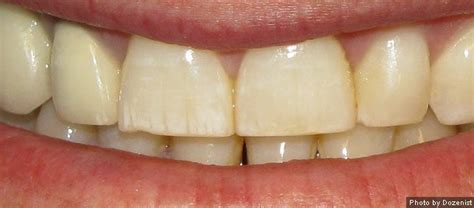Does Fluoride Yellow Teeth

The relationship between fluoride and tooth discoloration is a topic of significant interest, particularly in regards to the potential for fluoride to cause yellow teeth. To address this question comprehensively, it’s essential to delve into the effects of fluoride on dental health, the causes of tooth discoloration, and the specific impact of fluoride on tooth color.
Fluoride’s Role in Dental Health
Fluoride is widely recognized for its benefits in preventing tooth decay and strengthening tooth enamel. It is commonly found in toothpaste, community water fluoridation, and dental treatments. The incorporation of fluoride into dental care routines has been instrumental in reducing the prevalence of dental caries and improving oral health outcomes globally.
Causes of Tooth Discoloration
Tooth discoloration can result from various factors, including:
- Extrinsic Stains: These occur on the surface of the teeth due to exposure to chromogens such as those found in coffee, tea, and tobacco.
- Intrinsic Stains: These are incorporated into the tooth structure, often resulting from dental trauma, certain medications (like tetracycline), or excessive fluoride consumption during tooth development.
- Age-Related Discoloration: As people age, the enamel on their teeth becomes thinner, allowing the dentin (the layer beneath the enamel) to show through, giving teeth a more yellow appearance.
- Dietary Factors: A diet high in sugary or acidic foods and drinks can contribute to tooth discoloration.
Fluoride and Tooth Discoloration
The question of whether fluoride can cause yellow teeth hinges on the distinction between topical fluoride application (such as through toothpaste or professional dental treatments) and systemic fluoride ingestion, particularly during the developmental stages of teeth.
Topical Fluoride Application: When fluoride is applied topically (directly to the teeth), as with fluoride toothpaste or varnishes, it is generally not associated with tooth discoloration. Topical fluoride helps strengthen the tooth enamel, making teeth more resistant to decay without altering their color.
Systemic Fluoride Ingestion: The ingestion of excessive fluoride during the developmental stages of teeth (before they erupt into the mouth) can lead to a condition known as dental fluorosis. Dental fluorosis can cause changes in the appearance of tooth enamel, including discoloration. The severity of dental fluorosis can range from mild (barely visible lacy white markings) to severe (pitted and heavily stained or discolored enamel).
Dental Fluorosis and Yellow Teeth
Dental fluorosis, as a result of excessive fluoride exposure during tooth development, is the primary mechanism through which fluoride could potentially lead to yellow teeth. However, it’s crucial to differentiate between the terms “yellow” and “discolored.” While dental fluorosis can result in noticeable stains or discoloration, the appearance is often more nuanced than a straightforward yellowing. The stains can range from white or light yellow to dark brown, depending on the severity of the fluorosis.
Preventing Fluoride-Related Discoloration
To prevent dental fluorosis and potential tooth discoloration associated with excessive fluoride ingestion:
- Monitor Fluoride Intake: Ensure that children do not swallow toothpaste or mouthwash and use only a pea-sized amount of toothpaste.
- Community Water Fluoridation Levels: Be aware of the fluoride levels in your community water supply, especially if your child is under the age of 8.
- Dental Consultation: Consult with a dentist about the appropriate use of fluoride for your child’s age and developmental stage.
Conclusion
In conclusion, while fluoride itself is not directly associated with causing yellow teeth when used appropriately, excessive ingestion of fluoride during tooth development can lead to dental fluorosis, which may result in discoloration, including stains that could appear yellowish. The emphasis should be on the proper use of fluoride products, awareness of community water fluoridation levels, and regular dental consultations to prevent unnecessary exposure and ensure optimal dental health.
Can topical fluoride application cause tooth discoloration?
+No, topical fluoride application, such as through toothpaste or professional varnishes, is not associated with tooth discoloration when used as directed.
What is dental fluorosis, and how does it relate to tooth discoloration?
+Dental fluorosis is a condition caused by excessive fluoride ingestion during tooth development. It can lead to changes in tooth enamel appearance, including discoloration, which may appear as white or light yellow stains to dark brown, depending on the severity.
How can I prevent dental fluorosis and potential tooth discoloration in my child?
+To prevent dental fluorosis, monitor your child's fluoride intake, especially from community water and toothpaste. Ensure they do not swallow toothpaste and use only the recommended amount. Regular dental consultations can also help in assessing and managing fluoride exposure.
By understanding the effects of fluoride on tooth development and taking proactive steps to manage fluoride exposure, individuals can minimize the risk of dental fluorosis and maintain optimal dental health, avoiding the potential for tooth discoloration associated with excessive fluoride ingestion.

